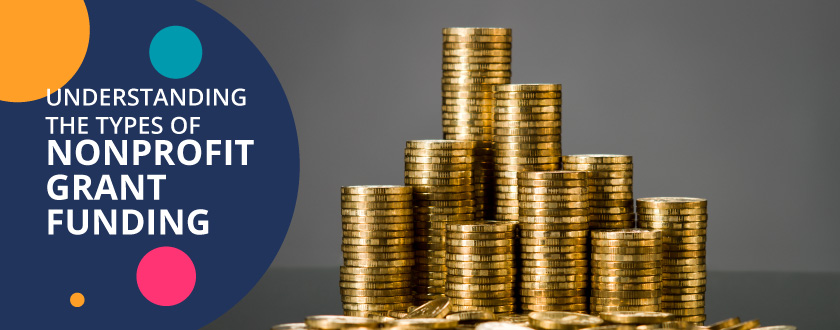Grants are an essential part of the nonprofit landscape, providing a significant percentage of the average nonprofit’s annual revenue. If you’re like most organizations, you depend on a mixture of grants, major gifts, sponsorships, and individual donations collected through fundraising campaigns and events.
Giving from foundations has steadily increased over the years, up by 2.5% to $105.21 billion between 2021 and 2022! There’s a lot of support out there to fund your programming, support capacity-building initiatives like tech investments, and in some cases, help cover operating expenses. However, you have to know where to look and what to look for before you can start choosing opportunities to pursue and drafting grant proposals.
This guide will review common funding sources and the types of grants that they typically offer.
Grant Funding Sources
Grants can come from a wide range of organizations. Let’s walk through some of the most common that you’re likely to encounter:
Foundations and Public Charities
Foundations are a diverse category of 501(c)(3) organizations, coming in all shapes and sizes. There are two main categories of foundations, differentiated by how they collect funds:
- Private foundations. These organizations are typically created by a single benefactor, whether an individual, family, or business. The foundation’s funds derive from that single source and are collected in charitable endowments. Family foundations and corporate foundations generally fall into this category, and while some are quite large and well-known, the average private foundation is small and tends to primarily fund local or single-issue causes.
- Public foundations (usually referred to as public charities). Like private foundations, these organizations are legally classified as 501(c)(3) nonprofits. However, public charities collect funds from the public and other funding sources rather than from a single source. Their purpose is not to serve constituents directly but rather to award grants and raise funds for nonprofits that provide direct services to constituents and communities. Community foundations are a good example, with donors pooling their assets to award grants and scholarships.
Government Grants
Federal, state, and local governments provide grants to a wide range of nonprofits and public services. Education, healthcare, and public media organizations are common recipients that rely heavily on government support. However, any organization can apply when relevant government grant opportunities are presented (and if they’re ready for the relatively intense application and management process).
Grants.gov is the central resource for all things related to federal grants, and state and local governments usually have their own resource centers and online directories, as well.
Corporate Philanthropy
Another diverse category of grant sources is the corporate world. Corporate philanthropy can take many forms, including:
- Grantmaking programs run through corporate foundations
- Official partnerships and sponsorships
- One-time gifts related to specific campaigns, projects, or events
- Matching gift programs to match donations made by employees
- Volunteer grants given in exchange for employee volunteered time
- Financial matches for employees raising peer-to-peer funds
- Annual workplace giving programs for local and partner nonprofits
Not all of these types of funding are considered “grants,” like matching gifts, which might instead be thought of as a smaller-scale recurring funding source. However, these are all excellent opportunities to diversify your revenue sources and get your foot in the door—matching gifts and small sponsorships can help you build relationships with the corporate philanthropy divisions that do offer larger grants.
As you work to strengthen your connections with businesses over time, it’s helpful to understand their motivations so that you can lay out more effective plans for structured partnerships. Nonprofits Source’s corporate giving guide identifies three core benefits for businesses:
- Tax incentives. Donations to 501(c)(3)s by corporations and most other types of businesses are tax-deductible, making corporate giving programs a savvy way for them to give back while proactively managing their tax bills.
- Positive publicity. Corporate social responsibility (CSR) is a powerful way for businesses to differentiate themselves from competitors and stand out as beneficial players in their communities. Offering valuable and concrete recognition options in your nonprofit’s partnership proposals will be key.
- Employee engagement and satisfaction. Businesses often roll out corporate giving programs as benefits for employees, but these programs can’t have the intended impact of engaging and satisfying employees if they’re underutilized. Active CSR initiatives and partnerships, though, increase engagement with these benefits, provide support for charitable causes, and create more appealing workplaces all at once.
If you’re looking to build a network of corporate partners and sponsors, start with easy philanthropy programs administered at the individual level, like matching gifts. Learn more about your donors and their employers, research corporate giving trends in your community, and reach out to introduce your organization to the relevant departments.
From there, you can start to build relationships similarly to how you would with a grantmaking institution, asking to be kept updated on new partnership ideas and opportunities. With a warm relationship, you’ll be in a great position to lay out customized sponsorship plans.
Donor-Advised Funds
Although not technically grants, donor-advised funds (DAFs) are philanthropic giving vehicles that function very similarly to grants. They were initially conceived as offshoots of community foundations. Here’s how they work:
- Donors deposit their funds in a special investment account through a sponsoring organization that will manage and invest the money for them. Financial service providers, community foundations, and single-issue charities all offer DAF services.
- The funds are managed and grown over time.
- The donor can then choose when and to which organizations to award donations from the fund.
Many donors appreciate this kind of hands-off approach to philanthropy that still allows them the ability to grow their assets. But for nonprofits seeking funding, identifying and securing DAF gifts requires a bit of work. This is largely because DAFs are distributed by the larger managing organization but technically given by the individual donor, meaning it can be difficult to find and build relationships with those donors in the same way one might with major gift prospects.
Reaching out to community foundations can be a good way to get started. Explore their networks of partners and donors to start uncovering new opportunities for your nonprofit.
Types of Grant Funding
Within all of the different sources of grant funding, you’ll also encounter different types of grant funding.
All grants fall into one of two categories, restricted and unrestricted. With restricted grants, you’re required to use that grant’s funding for specific programs articulated in your application. Often these have limitations on how much of the grant can be used to cover administrative costs. With unrestricted grants, you have complete control over where the funds are allocated in your organization, but these types of grants and gifts are less common. Only about 20% of funding for nonprofits has a degree of flexibility.
It’s also important to understand common management and reporting requirements. Grant requirements typically into one of these three groups:
- Unconditional grants. These grants have the fewest reporting strings attached, although you’ll still need to do some minimal financial reporting throughout the duration of the funding. These grants are awarded as full upfront funding that can be immediately recorded by your organization.
- Contingent grants. These grants typically provide funding in installments as you fulfill specific benchmarks laid out in your application and by the funder. Incoming funds must be carefully recorded as installments over time, and you should pay close attention to the reporting cadence required by the funder.
- Reimbursable grants. These grants provide funding after you’ve incurred and reported the costs of the program detailed in your application. These require especially careful tracking of expenses so that you can notify the funder once you’ve reached the total awarded amount. Government grants are often reimbursable and will require audits of your program expenses after the fact. If you secure a reimbursable grant, be prepared to show your receipts!
Remember that funders need to ensure that their grants are put to their designated use, and the requirements you’re held to as a recipient will directly impact how you can use the funds and the amount of additional work that will need to go into managing them. It pays to understand the general types of grants upfront.
Wrapping Up: What You’ll Need to Get Started
To get started building an effective grant seeking and management process, you’ll need a few essentials.
First, we recommend the help of grant seeking experts to help streamline the research, identification, and grant writing processes. These professionals can show you the ropes and help you build a reliable pipeline of grant opportunities to pursue over time. You’ll also need the team capability and knowledge necessary to properly manage and execute the grants that you secure.
And don’t forget the tech! Accounting software integrated with an organized database or CRM are must-haves. They’ll allow you to correctly record your incoming funds, track expenses, generate reports, and correlate program activities and constituent engagement with the grant over time.
A solid grants program with all the necessary infrastructure is an important investment for growing nonprofits since it can help you secure important sources of funding for years to come. As you develop a track record of success and build relationships with funders, you’ll find that it becomes easier to secure grants over time.
For relationship-building on the corporate side of things, look for tools that allow you to identify matching gift and volunteer grant opportunities. Matching gift databases and automation platforms make it easy to start building relationships with businesses organically. Find your donors who work for charitable businesses, and lean into those relationships. Then, grow your corporate giving efforts from there.
Thankfully, your entire funding strategy and grants program can be developed and grown over time, but the main takeaway is to be intentional and knowledgeable with how you do so. Understanding common grant sources and types of requirements is the perfect place to start. Best of luck!
About the Author: Sarah Dave, Managing Director at Grants Plus
 Sarah Dave is a Managing Director at Grants Plus, a national leader in grant seeking consulting. Grants Plus has secured $250 million in grant funding for nonprofit organizations around the country since 2007. In her role as Managing Director, Sarah equips the Grants Plus team to support clients and the broader philanthropic community. She has extensive experience in nonprofit management, donor strategy building, special events, direct marketing, and information management.
Sarah Dave is a Managing Director at Grants Plus, a national leader in grant seeking consulting. Grants Plus has secured $250 million in grant funding for nonprofit organizations around the country since 2007. In her role as Managing Director, Sarah equips the Grants Plus team to support clients and the broader philanthropic community. She has extensive experience in nonprofit management, donor strategy building, special events, direct marketing, and information management.

